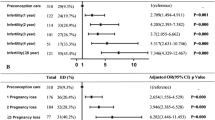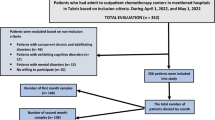Abstract
Sexual dysfunction (SD) has long been known to affect a significant number of people worldwide with serious implications and limitations on sexual expression and fulfillment. This may affect the sexual quality of life (SQoL) of individuals and their partners. A cross-sectional study was conducted among diabetic patients and their partners who visited the Tema General Hospital. A total of 130 and 116 diabetic males and females and their partners were interviewed. Male and female diabetic participants and partners were evaluated using the Golombuk Rust Inventory for Sexual Satisfaction–Male (GRISS-M)/SQoL-M and GRISS-Female/SQoL-F, respectively. For the diabetic males, the mean age and duration of diabetes (DOD) was 63.04±10.85 and 8.38±6.53 years, respectively, and that of the diabetic females was 56.98±9.42 and 6.11±5.31 years, respectively. Diabetic male participants with SD were significantly older and had a longer duration of diabetes. The mean SQoL and SQoL-Partner (SQoL-P) recorded for the diabetic males and their partners was 42.29±30.88 and 52.86±15.26, respectively. The mean SQoL and SQoL-P recorded for the diabetic females and their partners was 57.73±14.91 and 64.97±19.68, respectively. Diabetic males who had impotence had female partners with significantly lower SQoL-P scores, and similar results were recorded for those who had premature ejaculation, nonsensuality, avoidance and dissatisfaction problems. Female diabetics who had nonsensuality, avoidance and infrequency had male partners who recorded significantly lower SQoL-P scores. Female diabetics with higher perceptions of what an adequate intravaginal ejaculatory latency time (IELT) should be had male partners with significantly lower SQoL-P scores. Ageing and DOD are more likely to affect the sexual functioning of diabetic males than females. SD in diabetics with problems of impotence/vaginismus, premature ejaculation/anorgasmia, nonsensuality and avoidance has an adverse effect on the SQoL-P of their partners. Male partners of diabetic females who have a higher perception of IELT had a reduced SQoL. Ageing and longer DOD in diabetics are associated with a reduced SQoL-P of their partners.
This is a preview of subscription content, access via your institution
Access options
Subscribe to this journal
Receive 8 print issues and online access
$259.00 per year
only $32.38 per issue
Buy this article
- Purchase on Springer Link
- Instant access to full article PDF
Prices may be subject to local taxes which are calculated during checkout
Similar content being viewed by others
References
Enzlin P, Mathieu C, Van den Bruel A, Vanderschueren D, Demyttenaere K . Prevalence and predictors of sexual dysfunction in patients with type 1 diabetes. Diabetes Care 2003; 26: 409–414.
Rutte A, Van Splunter MM, Van Der Heijden AA, Welschen LM, Elders PJ, Dekker JM et al. Prevalence and correlates of sexual dysfunction in men and women with type 2 diabetes. J Sex Marital Ther 2015; 41: 680–690.
McCabe MP, Sharlip ID, Lewis R, Atalla E, Balon R, Fisher AD et al. Risk factors for sexual dysfunction among women and men: a consensus statement from the Fourth International Consultation on Sexual Medicine 2015. J Sex Med 2016; 13: 153–167.
Amidu N, Owiredu WKBA, Woode E, Addai-Mensah O, Gyasi-Sarpong KC, Alhassan A . Prevalence of male sexual dysfunction among Ghanaian populace: myth of reality? Int J Impot Res 2010; 22: 337–342.
O'Leary MP, Althof SE, Cappelleri JC, Crowley A, Sherman N, Duttagupta S et al. Self-esteem, confidence and relationship satisfaction of men with erectile dysfunction treated with sildenafil citrate: a multicenter, randomized, parallel group, double-blind, placebo controlled study in the United States. J Urol 2006; 175: 1058–1062.
Kandeel FR, Koussa VK, Swerdloff RS . Male sexual function and its disorders: physiology, pathophysiology, clinical investigation, and treatment. Endocr Rev 2001; 22: 342–388.
Guay AT, Spark RF, Bansal S, Cunningham GR, Goodman NF, Nankin HR et al. American Association of Clinical Endocrinologists medical guidelines for clinical practice for the evaluation and treatment of male sexual dysfunction: a couple's problem—2003 update. Endocr Pract 2003; 9: 77–95.
Guay AT, Spark RF, Bansal S, Cunningham GR, Goodman NF, Nankin HR et al. American Association of Clinical Endocrinologists medical guidelines for clinical practice for the evaluation and treatment of male sexual dysfunction: a couple's problem. Endocr Pract 2003; 9: 77–95.
Goldstein I, Fisher WA, Sand M, Rosen RC, Mollen M, Brock G et al. Women's sexual function improves when partners are administered vardenafil for erectile dysfunction: a prospective, randomized, double-blind, placebo-controlled trial. J Sex Med 2005; 2: 819–832.
Silvestri A, Galetta P, Cerquetani E, Marazzi G, Patrizi R, Fini M et al. Report of erectile dysfunction after therapy with beta-blockers is related to patient knowledge of side effects and is reversed by placebo. Eur Heart J 2003; 24: 1928–1932.
Hatzimouratidis K, Amar E, Eardley I, Giuliano F, Hatzichristou D, Montorsi F et al. Guidelines on male sexual dysfunction: erectile dysfunction and premature ejaculation. Eur Urol 2010; 57: 804–814.
Amidu N, Owiredu WKBA, Gyasi-Sarpong CK, Alidu H, Antuamwine BB, Sarpong C . The inter-relational effect of metabolic syndrome and sexual dysfunction on hypogonadism in type II diabetic men. Int J Impot Res 2017; 29: 120–125.
Corona G, Rastrelli G, Vignozzi L, Maggi M . Emerging medication for the treatment of male hypogonadism. Expert Opin Emerg Drugs 2012; 17: 239–259.
Alidu H, Amidu N, Owiredu W, Gyasi-Sarpong C, Bawah A, Dapare P et al. Testosterone and its bioactive components are associated with libido and the metabolic syndrome in men. Adv Sex Med 2017; 7: 105.
Althof SE . Quality of life and erectile dysfunction. Urology 2002; 59: 803–810.
Rosen RC, Althof S . Impact of premature ejaculation: the psychological, quality of life, and sexual relationship consequences. J Sex Med 2008; 5: 1296–1307.
Corona G, Giorda C, Cucinotta D, Guida P, Nada E SUBITO-DE study group. The SUBITO-DE study: sexual dysfunction in newly diagnosed type 2 diabetes male patients. J Endocrinol Invest 2013; 36: 864–868.
Corona G, Giorda CB, Cucinotta D, Guida P, Nada E . Sexual dysfunction at the onset of type 2 diabetes: the interplay of depression, hormonal and cardiovascular factors. J Sex Med 2014; 11: 2065–2073.
Corona G, Giorda CB, Cucinotta D, Guida P, Nada E SUBITO-DE study group. Sexual dysfunction in type 2 diabetes at diagnosis: progression over time and drug and non-drug correlated factors. PloS one 2016; 11: e0157915.
Yamada T, Hara K, Umematsu H, Suzuki R, Kadowaki T . Erectile dysfunction and cardiovascular events in diabetic men: a meta-analysis of observational studies. PLoS ONE 2012; 7: e43673.
Araujo AB, Durante R, Feldman HA, Goldstein I, McKinlay JB . The relationship between depressive symptoms and male erectile dysfunction: cross-sectional results from the Massachusetts Male Aging Study. Psychosom Med 1998; 60: 458–465.
Althof SE, Leiblum SR, Chevret‐Measson M, Hartmann U, Levine SB, McCabe M et al. Original research—psychology: psychological and interpersonal dimensions of sexual function and dysfunction. J Sex Med 2005; 2: 793–800.
Swindle RW, Cameron AE, Lockhart DC, Rosen RC . The psychological and interpersonal relationship scales: assessing psychological and relationship outcomes associated with erectile dysfunction and its treatment. Arch Sex Behav 2004; 33: 19–30.
Laumann EO, Nicolosi A, Glasser DB, Paik A, Gingell C, Moreira E et al. Sexual problems among women and men aged 40–80 y: prevalence and correlates identified in the Global Study of Sexual Attitudes and Behaviors. Int J Impot Res 2005; 17: 39–57.
Dennerstein L, Lehert P, Burger H . The relative effects of hormones and relationship factors on sexual function of women through the natural menopausal transition. Fertil Steril 2005; 84: 174–180.
Hisasue S-i, Kumamoto Y, Sato Y, Masumori N, Horita H, Kato R et al. Prevalence of female sexual dysfunction symptoms and its relationship to quality of life: a Japanese female cohort study. Urology 2005; 65: 143–148.
Rust J, Golombok S . The GRISS: a psychometric instrument for the assessment of sexual dysfunction. Arch Sex Behav 1986; 15: 157–165.
Rust J, Golombok S . The Golombok Rust Inventory of Sexual Satisfaction (GRISS) [manual]. NFER Nelson: Windsor, England, 1986.
Rust J, Golombok S . The Golombok-Rust Inventory of Sexual Satisfaction (GRISS). Br J Clin Psychol 1985; 24 (Pt 1): 63–64.
Abraham L, Symonds T, Morris MF . Psychometric validation of a sexual quality of life questionnaire for use in men with premature ejaculation or erectile dysfunction. J Sex Med 2008; 5: 595–601.
Schiavi RC, Rehman J . Sexuality and aging. Urol Clin North Am 1995; 22: 711–726.
Jamieson F, Chalmers J, Duncan C, Prescott RJ, Campbell IW . Erectile dysfunction in type 1 diabetic males. Br J Diabetes Vasc Dis 2008; 8: 232–234.
Webster L . Management of sexual problems in diabetic patients. Br J Hosp Med. 1994; 51: 465–468.
Feldman HA, Goldstein I, Hatzichristou DG, Krane RJ, McKinlay JB . Impotence and its medical and psychosocial correlates: results of the Massachusetts Male Aging Study. J Urol 1994; 151: 54–61.
Close CF, Ryder RE . Impotence in diabetes mellitus. Diabetes Metab Rev 1995; 11: 279–285.
Fedele D, Bortolotti A, Coscelli C, Santeusanio F, Chatenoud L, Colli E et al. Erectile dysfunction in type 1 and type 2 diabetics in Italy. On behalf of Gruppo Italiano Studio Deficit Erettile nei Diabetici. Int J Epidemiol 2000; 29: 524–531.
Jackson G, Betteridge J, Dean J, Eardley I, Hall R, Holdright D et al. A systematic approach to erectile dysfunction in the cardiovascular patient: a Consensus Statement—update 2002. Int J Clin Pract 2002; 56: 663–671.
Kratzik CW, Lackner JE, Märk I, Rücklinger E, Schmidbauer Jr, Lunglmayr G et al. How much physical activity is needed to maintain erectile function? Results of the Androx Vienna Municipality Study. Eur Urol 2009; 55: 509–517.
Owiredu WK, Amidu N, Alidu H, Sarpong C, Gyasi-Sarpong CK . Determinants of sexual dysfunction among clinically diagnosed diabetic patients. Reprod Biol Endocrinol 2011; 9: 70.
Mikhail N . Does testosterone have a role in erectile function? Am J Med 2006; 119: 373–382.
Owiredu WKBA, Amidu N, Alidu H, Sarpong C, Gyasi-Sarpong CK . Determinants of sexual dysfunction among clinically diagnosed diabetic patients. Reprod Biol Endocrinol 2011; 9: 1.
Acknowledgements
The study was privately funded by the authors.
Author contributions
WKBAO, HA, NA, CO, CKG-S and ATB developed the concept and designed the study; WKBAO, NA, HA, ATB, PPMD and ATL administered the questionnaire analysed and interpreted the data; WKBAO, HA, NA, ATB, PPMD, CO and CKG-S drafted the manuscript; WKBAO, HA, NA, CO, CKG-S, ATB and ATL revised the manuscript for intellectual content. All authors read and approved the final manuscript.
Availability of data and materials
Please contact author for data requests.
Author information
Authors and Affiliations
Corresponding author
Ethics declarations
Competing interests
The authors declare no conflict of interest.
Rights and permissions
About this article
Cite this article
Owiredu, W., Alidu, H., Amidu, N. et al. Sexual dysfunction among diabetics and its impact on the SQoL of their partners. Int J Impot Res 29, 250–257 (2017). https://doi.org/10.1038/ijir.2017.32
Received:
Revised:
Accepted:
Published:
Issue Date:
DOI: https://doi.org/10.1038/ijir.2017.32
This article is cited by
-
Diabetes technology and sexual health: which role?
Journal of Endocrinological Investigation (2023)
-
Sexual Dysfunction After Traumatic Injury Can Be Corrected by Transcranial Magnetic Stimulation: A Case Report
Archives of Sexual Behavior (2022)
-
The Experience of Indonesian Men Living with Type-2 Diabetes Mellitus and Erectile Dysfunction: A Semi-structured Interview Study
Sexuality and Disability (2021)
-
Prevalence of Diabetes Mellitus and Its Associated Factors in Bangladesh: Application of Two-level Logistic Regression Model
Scientific Reports (2020)
-
Association between clitoral tissue perfusion and female sexual dysfunction in healthy women of reproductive age: a pilot study
International Journal of Impotence Research (2020)



